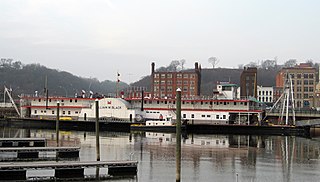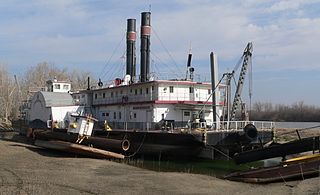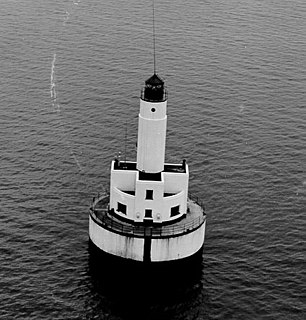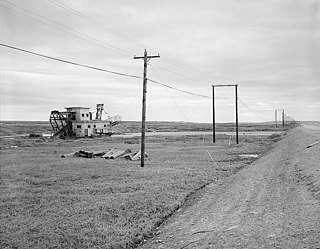
CSS Georgia, also known as State of Georgia and Ladies' Ram, was an ironclad warship built in Savannah, Georgia in 1862 during the American Civil War. The Ladies' Gunboat Association raised $115,000 for her construction to defend the port city of Savannah.

W. T. Preston is a specialized sternwheeler that operated as a snagboat, removing log jams and natural debris that prevented river navigation on several Puget Sound-area rivers. She is now the centerpiece of the Snagboat Heritage Center in Anacortes, Washington. She was designated a National Historic Landmark in 1989. Built in 1929, she is one of two surviving snagboats built and operated by the United States Army Corps of Engineers, and the only one on the American west coast.

Lettie G. Howard, formerly Mystic C and Caviare, is a wooden Fredonia schooner built in 1893 in Essex, Massachusetts, USA. This type of craft was commonly used by American offshore fishermen, and is believed to be the last surviving example of its type. She was declared a National Historic Landmark in 1989. She is now based at the South Street Seaport Museum in New York City.

The Sumpter Valley Gold Dredge is a historic gold dredge located in Sumpter, in the U.S. state of Oregon. Gold was discovered in Sumpter in 1862. Three gold dredges were put into service in the Sumpter Valley district between 1912 and 1934.

William M. Black is a steam-propelled, sidewheel dustpan dredge, now serving as a museum ship in the harbor of Dubuque, Iowa. Built in 1934, she is one of a small number of surviving steam-powered dredges, and one of four surviving United States Army Corps of Engineers dredges. She was declared a National Historic Landmark in 1992. She is open for tours as part of the National Mississippi River Museum & Aquarium.

Lone Star is a wooden hull, steam-powered stern-wheeled towboat in LeClaire, Iowa, United States. She is dry docked and on display at the Buffalo Bill Museum in LeClaire. Built in 1868, she is the oldest of three surviving steam-powered towboats, and the only one with a wooden hull. She was declared a National Historic Landmark on 20 December 1989.

Santa Cruz Looff Carousel and Roller Coaster On The Beach Boardwalk is a National Historic Landmark composed of two parts, a Looff carousel and the Giant Dipper wooden roller coaster, at the Santa Cruz Beach Boardwalk in Santa Cruz, California, United States. They are among the oldest surviving beachfront amusement park attractions on the west coast of the United States. They were listed as a pair as a National Historic Landmark in 1987.

The dredge Captain Meriwether Lewis is a U.S. National Historic Landmark. The dredge is one of the few surviving examples of its type built to control flooding and improve navigation along the nation's rivers.

Cleveland East Ledge Light is a historic lighthouse in Falmouth, Massachusetts. It sits on a man-made island in shallow water on the eastern of the two halves of Cleveland Ledge, which is said to have been named for President Grover Cleveland because he owned the nearby Gray Gables estate and used to fish in the area. It marks the east side of the beginning of the dredged channel leading to the Cape Cod Canal and is the first fixed mark when going northbound through the canal. As it is an important mark in an area subject to fog, it has a racon showing the letter "C".

The Marion Steam Shovel, also known as the Le Roy Steam Shovel, is a historic Model 91 steam shovel manufactured by the Marion Steam Shovel and Dredge Company of Marion, Ohio. It is located on Gulf Road in the Town of Le Roy, New York, United States.

Dock Bridge is a pair of vertical lift bridges crossing the Passaic River at Newark, Essex County and Harrison, Hudson County, New Jersey, United States, used exclusively for railroad traffic. It is the seventh crossing from the river's mouth at Newark Bay and is 5.0 miles (8.0 km) upstream from it. Also known as the Amtrak Dock Vertical Lift, it carries Amtrak, NJ Transit, and PATH trains. It is listed on the state and federal registers of historic places.

Wilmington Bridge is a historic concrete arch bridge over the Ausable River at Wilmington in Essex County, New York. It was built in 1934 and is an arch bridge faced with stone, 37 feet wide and spanning 160 feet at roughly 24 feet, 8 inches above water level. The bridge is maintained by the New York State Department of Public Works.

Lyons is a town in Wayne County, New York, United States. The population was 5,682 at the 2010 census. It is named after Lyon, France.

The Cadet shipwreck is an archaeological site located in Lake George near Bolton in Warren County, New York. It is the site of the shipwreck of the 1893-built Olive ex Cadet steam launch. It was a 48-foot-long, 9.6-foot-wide wooden steamboat with a pointed bow, and was found submerged in approximately 50 feet of water. The ship was discovered by Bateaux Below Inc. in 1997. In 2005, the ship was reported to be in fairly good condition, with its hull mainly intact.

Sainte Genevieve, also known as The Genny, was a steam powered Cutterhead dredge. At the time she was listed on the National Register of Historic Places in 1986 she was located on the Mississippi River along the levee near downtown Davenport, Iowa, United States.

Standard Oil Company No. 16 is a historic harbor tugboat located at Mariners Harbor, Staten Island, New York. She was built in 1907 by the Skinner Shipbuilding and Dry Dock Company of Baltimore, Maryland for the Standard Oil Company. She has heavy steel frames and deck beams. She is 100 feet in length, 23 feet in beam and 11.2 feet in depth. She is registered at 175 gross tons. She has an original wooden pilot house and the engine room dates to 1953-1954 when converted from steam to diesel. At that time, Standard Oil sold the tug to the McAllister Towing and Transportation Company and she was renamed John E. McAllister.

Alloway is a hamlet in the Town of Lyons, Wayne County, New York, United States near the Ontario County line. It is located 3 miles (5 km) south of the hamlet of Lyons, at an elevation of 433 feet. The primary cross roads where the hamlet is located are N.Y. Route 14, Alloway Road and Sohn Alloway Road.

The Fairbanks Exploration Company Dredge No. 2 is a historic gold mining dredge in a remote area of Fairbanks North Star Borough, Alaska, northeast of the city of Fairbanks. It is currently located on the north bank of Fish Creek, shortly northeast of the mouth of Slippery Creek. Its main structure is a compartmented steel hull, 128 feet (39 m) long, 60 feet (18 m) wide, and 12 feet (3.7 m) high, with a 1-2 story superstructure above made of steel and wood framing sheathed in corrugated metal. It has three gantries, and a digging ladder 112 feet (34 m) long at its bow that weights 178,000 pounds (81,000 kg). All of its original operating equipment was reported to be in place in 1999. The dredge was built in 1927 by the Bethlehem Steel Company, and assembled for use in Alaska in 1928. It was operated by the Fairbanks Exploration Company in the Goldstream Valley from 1928 to 1949, and on Fairbanks Creek and lower Fish Creek from 1950 to 1961.

The Swanberg Dredge is one of several gold mining dredges that dot the landscape near Nome, Alaska. Also known as the Johnson-Pohl Dredge, this one is located at about mile marker 1 of the Nome-Council Highway just inside the city limits. The dredge stands in a pond about 200 feet (61 m) north of the highway in a small pond. It has a barge-like hull with a mostly single-story superstructure, and measures about 60 by 30 feet, with a draft of 6 feet (1.8 m). Its metal frame bow gantry extends about 5 feet (1.5 m), and has a digging ladder 40 feet (12 m) long. The dredge was built in San Francisco, California, shipped to Nome, and placed in operation in 1946 by Walter Johnson. The economics associated with the cost of its construction and shipment, as compared to the price of gold, worked against Johnson, who only operated it for a single season before it was seized by a local bank. It has sat in place since then, typifying the sometimes hard-luck small-time mining operations of the area.

The Phoenix was a sidewheel paddle steamer operating on Lake Champlain between the United States states of New York and Vermont and the British province of Lower Canada. Built in 1815, she grounded, burned and sank in 1819 off the shore of Colchester, Vermont. Her surviving wreckage is the oldest known example of a sidewheel steamer anywhere in the world. The wreck site is a Vermont State Historic Site, which may be visited by registered and qualified divers. It was listed on the National Register of Historic Places in 1998.

























